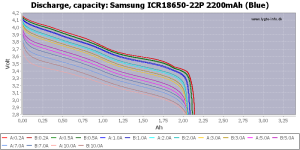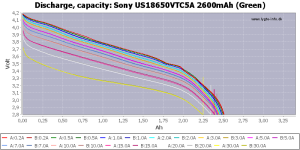jbnimble142
1 µW
Hello all.. I am in the process of building my 3rd battery pack, the 1st was a 72V spilt into 2 packs of SPIM08 modules thanks to youtube vids by jag35.com. The build method of using a hole punch and brass connector which was pressed worked well, that is until I shorted a pack by stacking to sets of batteries together and then trying to connect them. There are no shortcuts. I recently had a great discussion with the sanitation battery drop-off guy as 1 of the modules was still in good condition.
I had used an active battery balancer and it was not capable of performing the required amps needed by the motor, thus the Voltage dropped significantly and the 1 pack @36V was lost under load. From then I have moved to 18650 cells, the last pack I used Samsung 22P cells rated 10A/cell, I found a very useable spot welder and created a 17S5P pack in a 91-cell downtube case, it works very well.
My question is regarding the "P" in the configuration where the poles, both positive and negative have the same number of cells as the "P" configuration. Since the 91-cell cases are primarily for 36, 48 and 52-V builds when building larger series configurations you have open spaces in the battery holders. My thinking is that I can use these spaces to make the poles larger, for instance in a 17S build I could make the positive and negatives poles 6 or 7 in parallel and the rest of the cells in a 5P configuration. Could anyone comment on whether the draw from the poles would be too much for the pack. (I am using a JBD smart BMS and under load I noticed the B0 cell was drawing "red" and got bumped off the reading under high amp draws, I figured a larger pole would rectify this issue).
In all after 40 some odd cycles in the 5P configuration the cells are holding steady at .004MV balance... Should I on the next build play with the number of cells in the poles to offset the visual bumping I see in the BMS app.... Thanks!!!
I had used an active battery balancer and it was not capable of performing the required amps needed by the motor, thus the Voltage dropped significantly and the 1 pack @36V was lost under load. From then I have moved to 18650 cells, the last pack I used Samsung 22P cells rated 10A/cell, I found a very useable spot welder and created a 17S5P pack in a 91-cell downtube case, it works very well.
My question is regarding the "P" in the configuration where the poles, both positive and negative have the same number of cells as the "P" configuration. Since the 91-cell cases are primarily for 36, 48 and 52-V builds when building larger series configurations you have open spaces in the battery holders. My thinking is that I can use these spaces to make the poles larger, for instance in a 17S build I could make the positive and negatives poles 6 or 7 in parallel and the rest of the cells in a 5P configuration. Could anyone comment on whether the draw from the poles would be too much for the pack. (I am using a JBD smart BMS and under load I noticed the B0 cell was drawing "red" and got bumped off the reading under high amp draws, I figured a larger pole would rectify this issue).
In all after 40 some odd cycles in the 5P configuration the cells are holding steady at .004MV balance... Should I on the next build play with the number of cells in the poles to offset the visual bumping I see in the BMS app.... Thanks!!!



